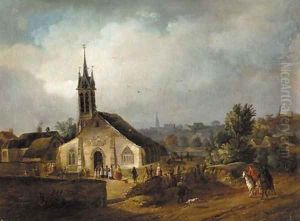Johann-Christian Brand Paintings
Johann Christian Brand was an Austrian painter and draughtsman born on March 6, 1722, in Vienna, Austria. He was part of a family deeply embedded in the arts; his father, Christian Hilfgott Brand, was also a painter, which provided Johann Christian with an environment rich in artistic influence from a young age. Throughout his career, Brand played a significant role in the development of landscape painting in the 18th century, particularly within the Austrian context.
Brand initially trained under his father before further honing his skills at the Academy of Fine Arts Vienna. His education and early exposure to art significantly shaped his artistic direction, focusing primarily on landscape and veduta (detailed cityscape) paintings. Brand's work was marked by a keen observation of nature and an ability to capture the changing moods of the landscape, a trait that distinguished him in the era of Enlightenment when there was a growing interest in nature and science.
In 1750, Brand became a court painter to Empress Maria Theresa of Austria, a position that not only elevated his status as an artist but also provided him with the opportunity to travel. These travels across Europe allowed him to study various landscapes, significantly influencing his artistic output. His works from this period show a blend of realism and romanticism, capturing both the physical accuracy of the landscapes and imbuing them with a sense of emotion and atmosphere.
Johann Christian Brand's contributions to the arts extend beyond his paintings. He was also a respected teacher at the Academy of Fine Arts Vienna, where he influenced the next generation of Austrian artists. His legacy is marked by his ability to capture the essence of the Austrian landscape, making him a pivotal figure in the evolution of landscape painting in his country.
Brand passed away on June 12, 1795, in Vienna. Today, his works are held in high regard and can be found in museums and collections across Austria and beyond, serving as a testament to his skill and his role in the history of art. His influence persisted through his students and through the continued appreciation of his approach to landscape painting, which emphasized the beauty and depth of the natural world.
